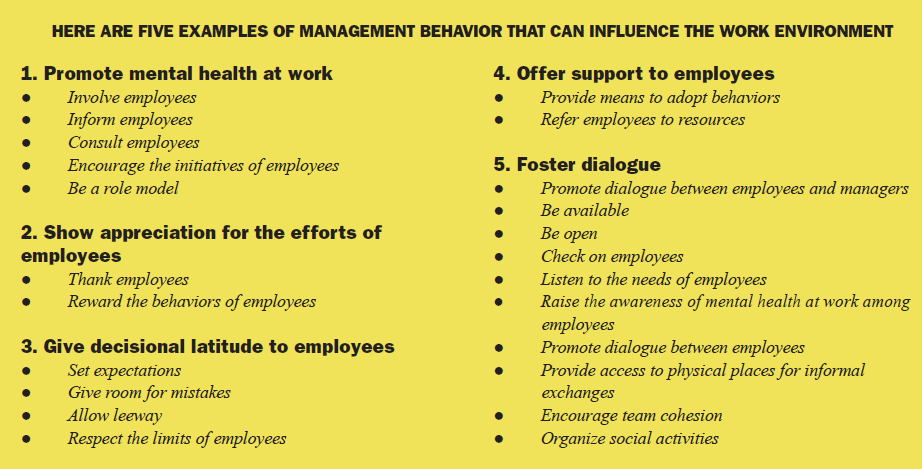Mental Health and the Role of Managers
BY DR. TYLER AMELL
According to recent research published by Gallup, there is significant overlap between low levels of employee engagement, including those actively disengaged and those classified as being “quiet quitters” in the U.S. workforce. (https://bit.ly/3Bts1ZD) This is an issue brokers, employers and human resources professionals must address in the near term, given its importance and impact on organizational success metrics such as profitability, revenue retention and customer satisfaction.
Employee engagement
Employee engagement is the strength of the bond or connection between people and the work they do, as well as between their teams and ultimately the organization. It can go above “discretionary effort.” It can be emotional and cognitive in nature, underscored by a sense of belonging and purpose. I have the privilege of traveling often on business, usually to speak at conferences or meet with employers. I check in and out of plenty of hotels, and I can easily tell which host agent is engaged and which is not within a short period. Employee engagement is currently at about 32%, with 18% actively disengaged, using recent Gallup data. These are not strong numbers compared to the nearly 10 years of increasing engagement levels recently reported on. During this time frame, active disengagement decreased as well, until very recently.
Quiet Quitting
“Quiet quitting” is the phenomenon of people not necessarily going above or beyond at work, and ‘only’ meeting the work details and deliverables outlined in their job descriptions. Using very recent Gallup data, over 50% of the U.S. workforce is currently made up of “quiet quitters.” The concept is receiving a lot of attention in the media. From my perspective, you can certainly have engaged people who are meeting, or even exceeding in performance measures, all while ‘only’ meeting the deliverables set out in their job descriptions. Brokers and employers should ask if it is a time commitment issue. Is the expectation that people work 24-7, even while on PTO? Is it a resource or skill issue? What about apathy? Inflation? And even whether “quiet quitting” should be an issue at all, since people are compensated through salary and benefits for meeting their job requirements, not necessarily for going above that level. This is traditionally what the individual bonus element of compensation is for, isn’t it? Labeling these people as “quitters” when most are certainly not, may foster a negative workplace culture and lead to the turnover and other negative issues employers should be trying to avoid. When you add in the concept of worker-wellbeing, which is an issue correlated with engagement and “quiet quitting” itself, the problem becomes compounded and not easily solved.
Mental health at work
Along with these issues, mental health concerns in the workplace have been steadily increasing, particularly in the years leading up to the pandemic period and have accelerated significantly during the first two and a half years of the pandemic. Current estimates are that between 55-59% of people are impacted by work-related stress alone, according to data from the American Psychological Association. Similarly, 87% of employees believe that actions from their employer would improve their mental health. From a condition perspective, nearly 20% of people are now impacted by anxiety disorders annually, and over 1 in 3 people are impacted by depression in the U.S. These conditions invariably have an impact on people from a work life and home life perspective. It is very difficult to separate work and home life, particularly in a hybrid work environment.
The role of managers
Brokers, employers and human resources professionals have been looking at mental health solutions to better support their clients’ people for years. There are a plethora of point solutions, digital offerings and integrated wellbeing platforms that can help. One avenue which can have a significant impact — but does not garner as much attention because it involves difficult leadership decisions — is the role that managers themselves play. Acclaimed author and researcher Marcus Buckingham once noted that people leave managers, not companies. Therefore, if poor management can lead to lower employee engagement, more ‘quiet quitters’ and poorer mental health, then better management can certainly result in the opposite.

A study published last year by the “International Journal of Human Resources Management” provides insight into how managers can promote improved mental health at work for their people. Managers should be concerned about mental health, and exhibit behaviors that reflect this concern in order to be more effective.
Similarly, there are behaviors and dialogue that can transcend mental health issues and help address employee engagement and the ‘quiet quitting’ phenomena. The following strategies are recommended, based in part upon the work of Jim Harter at Gallup and others:
Culture Eats Strategy for Breakfast: Know what your culture is, and continuously review it. Ensure the culture leadership wants permeates all aspects of the organization. The best strategy can be obfuscated by culture before it even gets off the ground.
Manager Engagement: According to Gallup, only 1 in 3 managers are engaged at work themselves, so this is a good place to start in order to address systemic problems.
Role Transparency: Many people have a hard time seeing how their roles and tasks fit in the big picture of what the organization’s larger purpose is. Addressing this helps drive a sense of belonging and supports a positive culture.
Collaboration and Dialogue: Listening to, understanding, and involving employees in decisions is critical. For example, where and when do people work? Do they have a voice in whether it is a hybrid environment, versus fully onsite or fully remote? A simple method is for managers to have a meaningful conversation with each of their people weekly, for at least 15 minutes. One of the best leaders I had in my career would make time a couple of mornings a week to visit and just chat. We came up with our best workplace health and disability management ideas during these chats.
Watch for Rust Out, Burnout and Disengagement: Know where your people are at the moment from a mental health perspective. Are they thriving? Struggling? What are the major things going in their life that could be of relevance to the workplace?
Treat Employees Like People: I try to make a conscious effort to refer to people that are part of an organization, not as workers or employees, or even contractors, but as people first. If you are a leader, looking at things through the lens of others will dramatically improve your own perspectives.
Together, these approaches can help brokers and the organizations they support address mental health, employee engagement and perhaps even rethink the ‘quiet quitting’ concept.

DR. TYLER AMELL is chief health & strategy officer at MediKeeper and an internationally recognized thought leader on the topic of workplace health and productivity. He also serves on the executive board of the National Wellness Institute and the Work Wellness Institute. In the past, he served on the executive board of the Integrated Benefits Institute (IBI) and the Canadian
Association for Research on Work and Health. He was a past partner and vice president at a global HR Consulting and Technology company, CEO of
a HR technology company and vice president of Canada’s largest independent health care, occupational rehabilitation, and return-to-work company.
Amell holds an adjunct faculty position at Pacific Coast University for Workplace Health Sciences. He has given seminars and presentations at more than 250 events globally. Contact: www.medikeeper.com
